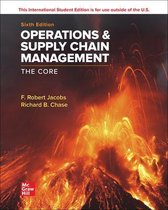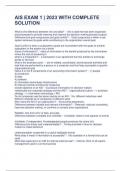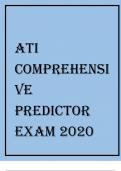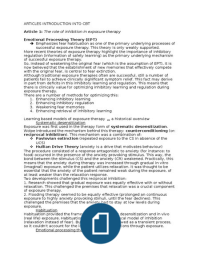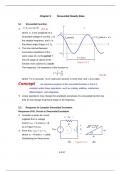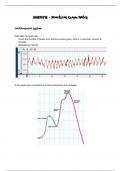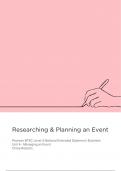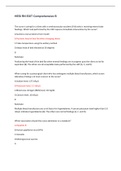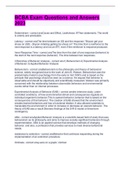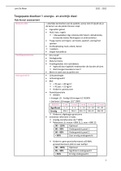GSCM, International Business, RUG
Chapter 1: introduction to OSCM
OSCM (operations and supply chain management) is defined as the design, operation,
and improvement of the systems that create and deliver the firm's primary products and
services.
Supply chain: all activities associated with the flow and transformation of goods and
services from raw materials to the customer, as well as the information and monetary flows
Operations: manufacturing and service processes used to transform resources into the
customer's desires
Logistics: plans, implements, and controls the efficient and effective flow and storage of
goods, services, and related information.
Inbound logistics: purchasing and production (material management)
Outbound logistics: physical distribution
Supply chain management: moving products and information to and from the
manufacturing and service processes of the firm.
Return of assets: net income / total assets
Asset turnover: sales (revenues) / total assets
In OSCM there are many processes: one or more activities that transform inputs into
outputs.
1. planning. A manager must plan how to operate an existing supply chain strategy.
how will the demand be met with the available resources? metric needed: monitoring
supply chains for efficiency and quality.
2. sourcing. selecting suppliers that will provide the goods and services needed to
create the firm’s product. metric needed: monitoring and improving the relationship
between the partners.
3. making. creating the major product or the service is provided. this requires making
schedules for workers and coordinating material and other critical resources to
support providing the product/service. metrics needed: checking the speed, quality,
and worker productivity.
4. delivering: carriers are picked to move products, coordinate and schedule, develop
and operate a network of warehouses and run information systems that manage
receipt and payments
5. returning: receiving worn out, defective and excess products from customers and
helping customers who have problems with the delivered products.
,differences between services and goods:
intangible, interaction, heterogenous, time-dependent, evaluated by the five senses
● services aren’t tangible and goods are
● service innovation cannot be patented and goods can
● customers can’t try out a service before purchase
● a service requires interaction with the customer
● services are highly heterogenous and goods can be produced with tight
specifications
● services are very perishable and time dependant
● services cannot be stored
● services are defined and evaluated by the five senses.
pure goods (mining, chemicals, and food) —> core goods (automobiles) —> core services
(internet providers and hotels) —> pure services (medical and school)
product-service bundling: when companies build service activities into its products offering
to create additional value for the customer
however, product-service bundling produces a higher revenue, although it has a lower profit
than focused firms, because of the additional costs of the services
criteria to how a company is doing:
efficiency: doing something, while generating the lowest input of resources.
effectiveness: doing the right things to create the most value for the customer.
sometimes they can be the opposite of one another. for example, having many checkout
lines will generate a lot of effectiveness, but it is not efficient.
value created in products and services: the attractiveness of a product relative to its price
benchmarking: when a company studies the processes of another company to identify best
practices.
in order to compete, companies want to be right (quality), fast, on time, able to change, and
productive (cost)
manufacturing strategy: how a factory’s capabilities can strategically be used to gain an
advantage over a competing company. 1970 - 1980
JIT (just in time): an integrated set of activities designed to achieve high-volume production
using minimal inventories of parts that arrive exactly when they are needed
TQC (total quality control): aggressively seeks to eliminate production defects
lean manufacturing: a term used to refer to the set of concepts relating to tqc and jit 1980
, TQM: managing the entire organization to excel in all dimensions of products and services
that are important to the customer. 1980 - 1990
BPR (business process reengineering): an approach of improving business that seeks to
make revolutionary changes as opposed to small changes
six sigma: a statistical goal to describe the quality goal of no more than 3.4 defects out of
every million units.
outsourcing: when a company hires a third party to do a certain task.
mass customization: the ability to produce a certain good exactly to a particular customer's
requirements.
electric commerce: the use of the internet as an essential element of business activity.
sustainability: the ability to meet current resource needs without compromising te ability of
future generations to meet their needs
triple bottom line: a business strategy that includes social, economic, and environmental
criteria.
business analytics: the use of current business data to solve business problems using
mathematical analysis
possible future challenges:
● adapting to rapidly changing global business relationships. china and asia are
getting more powerful play in the world because they excel at producing with low
costs.
● accommodating the shift to online retail purchasing
● optimizing global supplier, production, and distribution networks
● the speedy adoption of new technology and automation
the ability to evaluate the potential financial impact of a change is the goal of the SCIM. this
is a mathematical version of a diagram.
reasons for globalization:
● attract and retain global talent
● attract new market
● reduction of costs
● providing better goods and services
● learn to improve operations
Three-stage process for supplier selection:
● vendor evaluation
● vendor development
● negotiations
Chapter 1: introduction to OSCM
OSCM (operations and supply chain management) is defined as the design, operation,
and improvement of the systems that create and deliver the firm's primary products and
services.
Supply chain: all activities associated with the flow and transformation of goods and
services from raw materials to the customer, as well as the information and monetary flows
Operations: manufacturing and service processes used to transform resources into the
customer's desires
Logistics: plans, implements, and controls the efficient and effective flow and storage of
goods, services, and related information.
Inbound logistics: purchasing and production (material management)
Outbound logistics: physical distribution
Supply chain management: moving products and information to and from the
manufacturing and service processes of the firm.
Return of assets: net income / total assets
Asset turnover: sales (revenues) / total assets
In OSCM there are many processes: one or more activities that transform inputs into
outputs.
1. planning. A manager must plan how to operate an existing supply chain strategy.
how will the demand be met with the available resources? metric needed: monitoring
supply chains for efficiency and quality.
2. sourcing. selecting suppliers that will provide the goods and services needed to
create the firm’s product. metric needed: monitoring and improving the relationship
between the partners.
3. making. creating the major product or the service is provided. this requires making
schedules for workers and coordinating material and other critical resources to
support providing the product/service. metrics needed: checking the speed, quality,
and worker productivity.
4. delivering: carriers are picked to move products, coordinate and schedule, develop
and operate a network of warehouses and run information systems that manage
receipt and payments
5. returning: receiving worn out, defective and excess products from customers and
helping customers who have problems with the delivered products.
,differences between services and goods:
intangible, interaction, heterogenous, time-dependent, evaluated by the five senses
● services aren’t tangible and goods are
● service innovation cannot be patented and goods can
● customers can’t try out a service before purchase
● a service requires interaction with the customer
● services are highly heterogenous and goods can be produced with tight
specifications
● services are very perishable and time dependant
● services cannot be stored
● services are defined and evaluated by the five senses.
pure goods (mining, chemicals, and food) —> core goods (automobiles) —> core services
(internet providers and hotels) —> pure services (medical and school)
product-service bundling: when companies build service activities into its products offering
to create additional value for the customer
however, product-service bundling produces a higher revenue, although it has a lower profit
than focused firms, because of the additional costs of the services
criteria to how a company is doing:
efficiency: doing something, while generating the lowest input of resources.
effectiveness: doing the right things to create the most value for the customer.
sometimes they can be the opposite of one another. for example, having many checkout
lines will generate a lot of effectiveness, but it is not efficient.
value created in products and services: the attractiveness of a product relative to its price
benchmarking: when a company studies the processes of another company to identify best
practices.
in order to compete, companies want to be right (quality), fast, on time, able to change, and
productive (cost)
manufacturing strategy: how a factory’s capabilities can strategically be used to gain an
advantage over a competing company. 1970 - 1980
JIT (just in time): an integrated set of activities designed to achieve high-volume production
using minimal inventories of parts that arrive exactly when they are needed
TQC (total quality control): aggressively seeks to eliminate production defects
lean manufacturing: a term used to refer to the set of concepts relating to tqc and jit 1980
, TQM: managing the entire organization to excel in all dimensions of products and services
that are important to the customer. 1980 - 1990
BPR (business process reengineering): an approach of improving business that seeks to
make revolutionary changes as opposed to small changes
six sigma: a statistical goal to describe the quality goal of no more than 3.4 defects out of
every million units.
outsourcing: when a company hires a third party to do a certain task.
mass customization: the ability to produce a certain good exactly to a particular customer's
requirements.
electric commerce: the use of the internet as an essential element of business activity.
sustainability: the ability to meet current resource needs without compromising te ability of
future generations to meet their needs
triple bottom line: a business strategy that includes social, economic, and environmental
criteria.
business analytics: the use of current business data to solve business problems using
mathematical analysis
possible future challenges:
● adapting to rapidly changing global business relationships. china and asia are
getting more powerful play in the world because they excel at producing with low
costs.
● accommodating the shift to online retail purchasing
● optimizing global supplier, production, and distribution networks
● the speedy adoption of new technology and automation
the ability to evaluate the potential financial impact of a change is the goal of the SCIM. this
is a mathematical version of a diagram.
reasons for globalization:
● attract and retain global talent
● attract new market
● reduction of costs
● providing better goods and services
● learn to improve operations
Three-stage process for supplier selection:
● vendor evaluation
● vendor development
● negotiations

